#asian + oriental inspired designs *_*
Explore tagged Tumblr posts
Photo

Spice up your home ambiance with a Japanese Floor Table. It seamlessly blends tradition with style, ensuring a perfect spot for cozy gatherings right in your living space. Explore our top picks!
#Japanese furniture#floor table#home decor#interior design#home furniture#minimalist design#Asian inspired decor#cultural furniture#home style#living room ideas#furnishing tips#Japanese floor table#best choices for home#Zen home#Japanese home#unique furniture#functional design#home improvement#home accents#oriental decor
2 notes
·
View notes
Text
Golden Glow of a Lake Pavilion - Posters with Elegant Frames"Posters with Wooden Frame

A captivating artwork featuring a serene Asian-style pavilion glowing warmly by a tranquil lake, surrounded by lush greenery and tropical plants. The soft reflections in the water and intricate architectural details evoke a sense of peace and harmony, making it a perfect piece for home or office decor when framed in a wooden design.
visit our store for more designs
#wall art#wallart#wallpaper#designs#wall painting#wooden frame wall art#framed posters#Asian Pavilion#Wooden Frame Poster#Zen Architecture#Lake Reflection#Illuminated Pavilion#Serene Landscape#Tropical Forest#Wall Art Decor#Peaceful Ambiance#Nature-Inspired Art#Oriental Style
0 notes
Text
🌸 Step into the World of Timeless Serenity! 🌸

Transport yourself to a place where tranquility reigns supreme. "Timeless Serenity" is more than just art—it’s an experience of peace, inspired by the elegance of traditional Eastern ink landscapes.
🏯 Picture two beautifully detailed temples perched on the edge of a calm river, connected by a rustic wooden bridge. Misty mountains stretch into the horizon, while graceful birds soar above, bringing life to this serene masterpiece.
🖌️ Designed for lovers of Asian culture, minimalist art, and nature’s harmony, this piece adds sophistication and calmness to any space—whether it’s your home, office, or meditation corner.
✨ Perfect for: ✅ Creating a calming ambiance. ✅ Celebrating traditional Eastern art. ✅ Gifting to art and culture enthusiasts.
💥 Limited Availability! Bring this timeless piece into your life today. 📦 Available in prints and framed options for all spaces.
👉 Order now and let this artwork transform your space into a sanctuary of serenity.
🌟 Click the link below to shop today! 🌟
Dear Customer Click here for more information
#Traditional Eastern Art#Ink Landscape Painting#Oriental Architecture#Temple Artwork#Misty Mountains#Asian Zen Art#Nature-Inspired Art#Serene Landscape#Hand-Drawn Ink Art#Peaceful Decor#Calming Wall Art#Eastern Culture#Minimalist Art Design#Tranquility Artwork#Asian-Inspired Decor
1 note
·
View note
Text
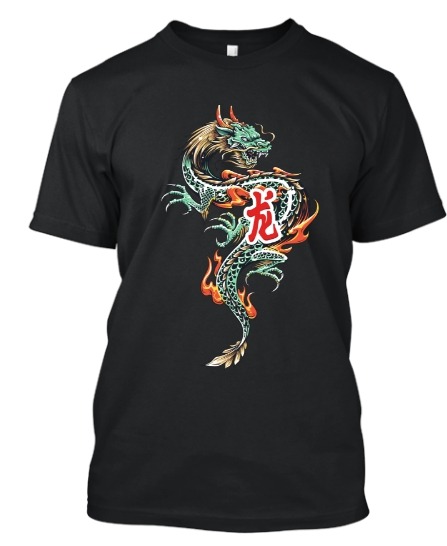
"Premium Dragon Graphic T-Shirt - Unique Oriental Style for 2024"
"Shop the trendiest Dragon Graphic T-Shirt for 2024 featuring an intricate Oriental design. Perfect for casual wear, this high-quality black tee combines bold colors with a fiery dragon motif, ideal for making a statement. Available now in all sizes."
#dragon graphic t-shirt#oriental style t-shirt#trendy dragon tee 2024#unique t-shirt designs#black dragon t-shirt#Chinese dragon shirt#casual fashion 2024#fire dragon t-shirt#bold graphic t-shirts#Asian-inspired t-shirt design
0 notes
Text
Monster High and East Asian Representation
Alright MH fans, we need to have a semi-serious conversation about how East Asian rep has been handled in the franchise. Representation itself has been a big point of conversation in the community, so it's important to talk about all of its aspects. The good, the bad, and the ill-conceived.
For context, I am an East Asian-American who has seen time and time again her culture be misrepresented, boiled down to stereotypes, and even mocked by other Asian cultures. Am I the all-time expert? Absolutely not, which is why I encourage other East Asian/Asian-American fans to give their comments about the franchise's handling of Asian characters.
Now then, we'll start with G1 since it probably has some of the most infamous pieces of representation
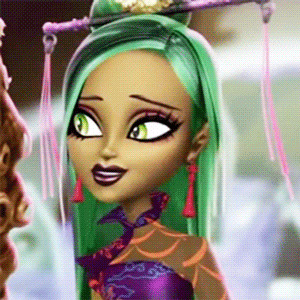
There is a lot to unpack with G1 Jinafire's design and personality. Not only the choice of golden skin, the misguided outfit choices, and emphasis on honor and discipline, but also the oriental riff often accompanying her in every backing scene. Highly encourage people to look into the Asian Dragon Lady stereotype, because unfortunately, that is what Jinafire is.
It is acknowledgeable that Jinafire's voice actress, Stephanie Sheh, is also Chinese, but there is still error with her character as a whole. Jinafire was personally one of the first Asian characters in media that I was introduced too, so it's upsetting to reflect on how negative her character design is.
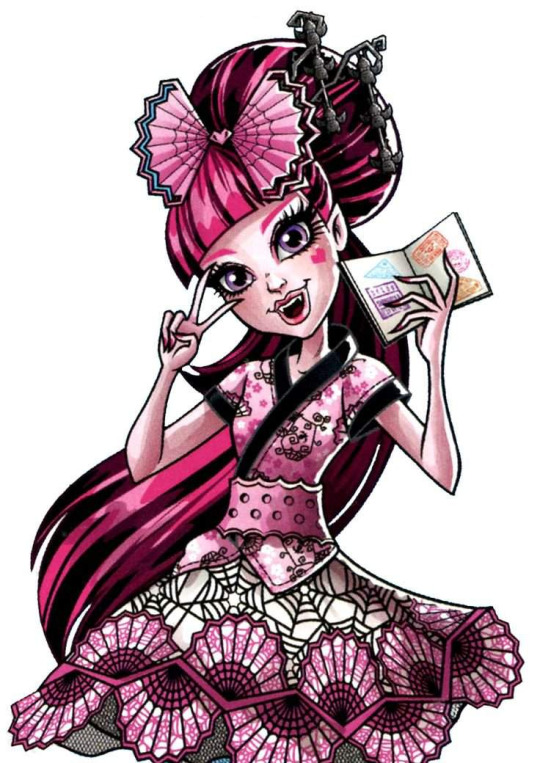
Shibooya is... not great. The exchange program as a whole feels like a minefield of issues (though I don't have much liberty to discuss the other transfers), and this one especially rubbed me the wrong way. They gave the vampires of Shibooya yellow skin, and the doll is supposed to kimono-inspired while hardly even resembling one.
Harajuku style was right there and easily fit the fashions of Monster High. There are also a number of Japanese yokai that could've been featured within the short and would have likely been better representation than the vampires.
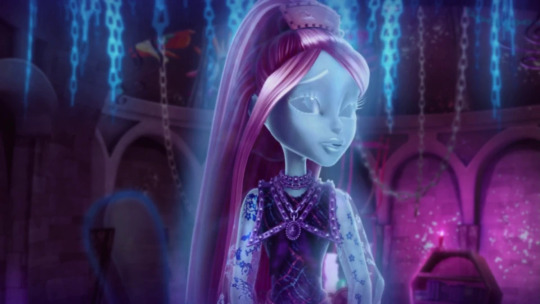
Kiyomi is okay, and certainly an improvement compared to the previous G1 characters. She's based off the Noppera-bo, aka the faceless ghost, and it's used decently in her design. However, her personality is boiled down into being shy, quiet, and reserved, which is a stereotype many Asian girls face under the name "Lotus Blossoms". She even has blossoms on her dress sleeves, and her outfit again is a loose interpretation of a kimono.
There are a number of modern Japanese outfit designs that could be used, and kimonos are often associated with modesty and respect. Kimonos are not meant to be revealing in any way, covering the body in full and being intricately wrapped. I personally take issue with the designers noting her chains meaning to resemble the sailor collar, which is used in middle school uniforms, not high school uniforms.
Kiyomi is, of course, hardly mentioned and refined to a movie role, in which she copies and mimics the personality/style of an European character.
Now onto G3!

Honestly, nothing really to critique here! Draculaura's been canonically been confirmed to be at least half-Taiwanese and speaks Mandarin. Now would it be nicer to get more appearances of her culture other than a couple throw-away lines? Yes it would, but there isn't anything really negative about this portrayal. I think it'd be interesting if Draculaura had a Taiwanese name she went by around her mother, or just casual moments of her eating scallion pancakes or aiyu jelly.
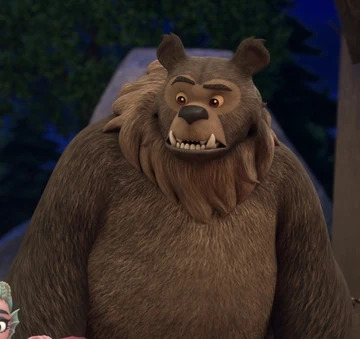
aaaaaand here's where we automatically fall back on representation. This may not seem that major to people, but considering this is the first Japanese character we get in G3, it's not great. Points for the writers looking past the most common yokai, but I don't know any person that wants to be represented by an animal.
I really do need people to realize how this is compared to the other characters. I wasn't initially reactive to Kuma's introduction until I realized they were making him a consistent character. Considering we don't have many other anthro/fully monstrous characters, and they chose to make him the Japanese representation doesn't seem right. Especially since they gave him the lead in the cultural appropriation vs. appreciation episode. An excellent episode, but it loses some sentiment coming from a literal bear.
Plus I would implore you all to rewatch Horrorscare and take a close look at the Japanese water dragon Pearl. And I'll remind you she exists in the same world as Jinafire.

now this is what I'm talking about! Not only has the skin issue been resolved, but the creators took a step in the right direction and made Jinafire more akin to Chinese dragons, who are often connected to storms and rain. Her outfit is also much more akin to street fashion in China. I still wish there was more to see with Jinafire's character, but she absolutely an improvement to her G1 iteration!
Well that's a lot to unpack there! Again, I am in no way the expert on East Asian representation and I'm going to miss some things. I encourage other fans to think about these characters and how you feel about them, and maybe even point out things I missed, good or bad! I did this simply out of my own feelings and wanted to see if anyone else felt the same.
#monster high#monster high g3#monster high gen 1#mh g1#mh g3#draculaura#jinafire long#kiyomi haunterly
90 notes
·
View notes
Text
Hauteville House. Part 1
I’ll start with the oriental motifs in the interior of Hauteville House. Hugo was one of the intellectual founders of orientalism: though he never travelled to the East, he held strong opinions about it and was never shy in sharing them. The entire house is a curious mixture of oriental and gothic elements. He had a particular love for low divans inspired by Muslim interiors—they’re everywhere. But the strongest sense of oriental influence is felt in the so-called Red and Blue Rooms, both designed as sitting rooms.
The Red Room evokes a theatre and was partly inspired by Hugo’s childhood in Spain, but it also features African figures and Asian ornaments. The Blue Room, on the other hand, is covered with damask and adorned with chinoiseries. Hugo and his son scoured shops on Guernsey and in England for various pieces of Chinese furniture. A beautiful set of blue and gold glass-bead embroideries, originally bought for his lover Juliette Drouet (who lived next door), adds a stunning touch to the room’s decor.
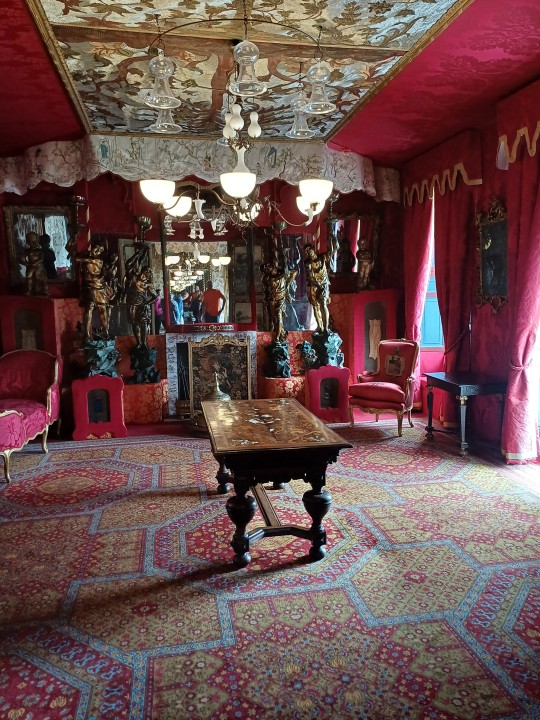
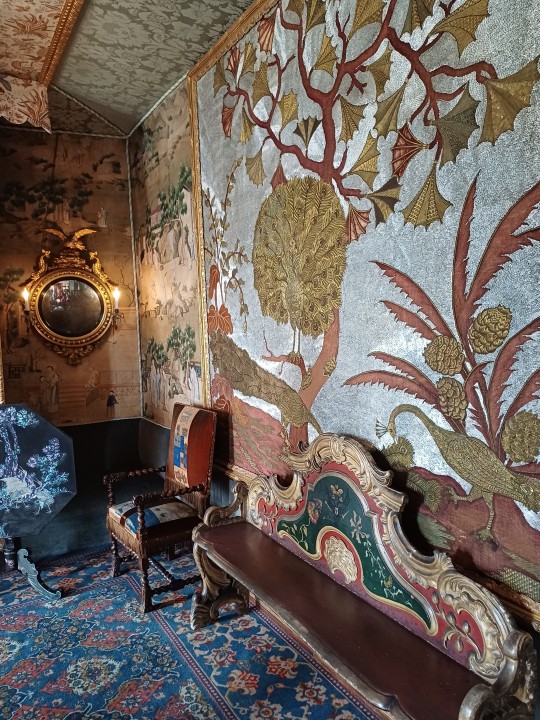

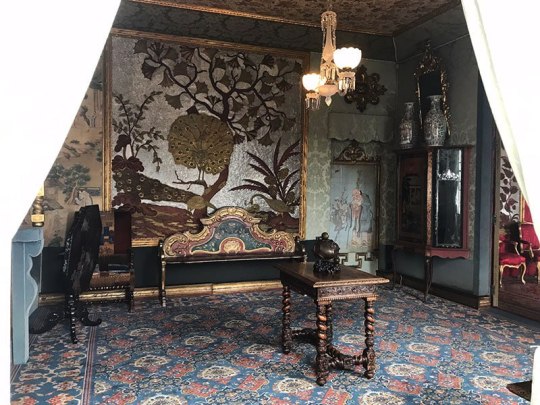
This mixture of oriental and gothic aesthetics is present throughout: a medieval mirror against Chinese wallpaper, and Chinese figures above the entrance of his eclectic Delft-style dining room.

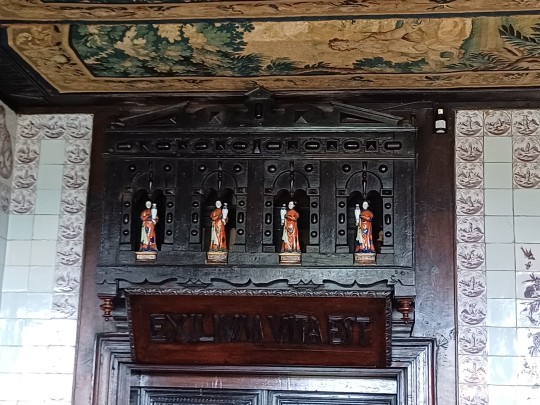
A gift from Hugo’s close friend, Alexandre Dumas, a bronze scent burner.


My favourite orientally-inspired piece is the two wooden panels in Hugo’s private room. He personally carved a story of a knight and a dragon (reminiscent of St. George's legend) for his grandchildren. The dragon itself is very oriental—it was inspired by another piece of Chinese furniture on the ground floor of the house. He used to tell his grandchildren stories about the dragon, and then he carved and painted it. The panels feel strikingly modern, almost Art Nouveau. You can even see Hugo’s initials carved in the lower corner.


35 notes
·
View notes
Text
I'll be your docent for today.
yeah so I want to take a little look at the scroll of Fanelia because when I first saw it, it made me think of old "Indian" and "Persian" art, but that's such a vague description. I'll basically be walking through this like a tour guide in a museum, giving my best estimates and interpretations, that's all.
Aside from the scroll, we don't see more figurative painted art from Fanelia (we see the murals) but we do have other art with which we can compare and contrast. This is sculpture rather than illustration, but the inspirations are similar and so it helps orient us to a place.


Yamantaka and Vajrapani

This is the broken statue on the ground of burnt-out Fanelia in episode 17. It's the flames that really do it for me. The deities depicted above are, respectively, "the destroyer of death" and "holder of the thunderbolt," and like this beastly draconic figure, they're depicted with flame aureolae.


Two Garuda (Hindu and Buddhist deity,) one mounted on the roof of a Tibetan temple— at the corner of the roof similar to the Thai chofa— and one ridden by Vishnu.
Alright. Now, the scroll, Fanelia's ancient texts (or part of them.)

So it looks like this was painted onto woven material rather than being embroidere because we can see some of the pigment's worn off. The border/register could be painted on or it could mean it was fixed to an additional textile, as was common with Tibetan thangka paintings.
Ah and look, you can see the membrane of its wings and the energist in its chest. Man, see at the guy on the far left, running but holding the hand of his fallen wife/child? Brutal. Also, it looks like the dragon got in past Fanelia's gates if that's what the structure on the right is. Interesting... perhaps this was an inciting event which kicked off the tradition of killing dragons? It's being highlighted here and we haven't heard/seen of dragons entering Fanelia aside from episode 22, when they're roaming the ruins. Which might imply that this dragon is only here because it was provoked. Perhaps shortly after the proper founding of Fanelia...? The dragons must've lived here first, right?
if you saw old Persian art you might be forgiven for thinking it were more far east than middle east, but these are just names given to huge regions with constant overlap. Nowhere is a monolith, and Central Asia did numbers as far as bridging Asias major and minor. But of course, the Escaflowne team couldn't pull inspiration for the dragons from Tibetan, or Bhutanese, or even Persian art, because the dragons were much too similar to east asian dragons! Check this out:


Ferdowsi's Persian epic, the Shahnameh
Eastern dragons wouldn't hold any negative connotations for the target audience. So Escaflowne's land dragons look different. They still hold wish-granting pearls, the dragons are still venerated and are benevolent unless provoked, but they can't look familiar, or else they take on a different character. It makes the reveal of their base goodness more impactful if we think they're ugly and ferocious.
(It's not my opinion that the dragons are ugly, lol— they follow a more European design, and dragons in medieval/european folklore were almost exclusively a symbol of evil, and often annanalogue for the devil, so they were supposed to look weird and nasty. I don't equate ugliness with evil, but a lot of people did!)
Let's take a look at the statue in Asturia vs the many-times repeated (in western Europe) motif of St. George and the Dragon.


Asturia supposedly worships a kind of sea dragon, called Jeture/Jichia/ジェチア, who has the power to grant righteous wishes and punishes ill-intended ones. If so venerated, why then this statue of a person killing a dragon? Just like how Fanelia is "protected" by the same dragons they kill, this makes Asturia as much of a hypocrite. To drive that home, we only see this statue while Folken is talking about man's impulse toward slaughter.
This much more European statue and the tower next to it provide a strange contrast to the Arab or even Babylonian architecture of the city. This statue, complete with halo and mimicking the "stepping on the devil" motif, invokes a much more Christian connotation than, at the very least, the area the royals occupy.
also it's funny to me that the name of the sea god, Jichia, is so similar to Arabic jizya— the tax levied on non-Muslim citizens in places like Al-Andalus (Andalusia) during various Caliphates and empires in exchange for protection and abstaining from conscription. Asturia's paying the tax for not being Asian lmao
The real life Asturias in northern Spain was the home of Celtic peoples, and later a stronghold in defiance of the Muslim conquest, which was helped by being sequestered by the mountains— it was a pain in the ass to get there. To me, this might mean that the fictional Asturia, too, is in denial of what gave it greatness, in pursuit of a more "sophisticated" European image, but just can't quite bring itself to tear down its gates of Ishtar. Asturia seems like a bit of an opportunist, in their alliances! Appearing as one thing to then reveal a disingenuous truth? Yup, we're in Allen Schezar territory alright. Allen "Shockingly Arab Surname" Schezar territory.
Anyway I don't think it's just Persian art that's inspiring the scroll, though. The armour on the main figure resembles the GOAT of all time, the Timurids and/or Mongols, and their influence on Tibet by way of China (mainly.) I am going to move on now though to old Indian art. The thing that made me think of it in the first place are the large eyes and noses in profile.




Also the facial hair. Based on how everyone else looks, and based on the mountains that stretch from Fanelia to Freid (practically mirroring the Himalayas) it makes sense to me that there are stylistic similarities between Goau and Mahad that don't appear on anyone else. Even the casual clothes in Fanelia look more like Freid's than any other place/people. Both Mahad and Goau wear the same shade of royal purple, too! But Goau's entire outfit is purple, and Mahad's flourish is just a sash draped over a white outfit. In Escaflowne, truth/awareness is represented by white/pale blue light. In that case, I'll also take his sash to mean that being a ruler is only half of who he is. A man of the people.



i'm in love with him


this bitch can suck eggs
Not to blow it wide open, but: these guys are supposed to be literary parallels. This happens via Chid, Van basically acknowledges this but it's through reaction, not words. Mostly. Van encourages Chid not to doubt Allen, the same way Balgus encouraged him— for a time, until he stopped— not to doubt Folken; doubting Folken has/had been a torturous task for Van. Chid, being a young boy with the burden of a country at war on his shoulders, depicts how Van and Folken were, or could've been, ostensibly brought up by their father, knowing what we do about how Balgus trained them, and about Fanelia's militancy in general. We do not see the brothers interact with Goau at all save for 1 moment, Van's birth— so Duke Freid is filling that in for us. However in a few key places, they're also very different guys, just as nothing in Escaflowne is as it seems on first pass.
It makes sense narratively, and the visuals serve to suggest that link— but, in classic Escaflowne fashion, it doesn't have to stand out, it's just played straight.

Mountain ranges are not just barriers, they also create bridges. It does also make sense geographically, not just for the literal area above but the general area and inspiration of south asia— mountains stretching down to a steppe/plateau, or right down to the water in the case of Freid. That type of environment exists in Japan, but also Iran, Indonesia, India, Taiwan, to name a few.
I mentioned Persian and Indian art. The little figures in the scroll are pretty simple, and there actually isn't a lot of art from the region that depicts people like this. There's no art from Japan that depicts people like this. Finding pre-buddhism Tibetan art is next to impossible. But! We have other places we can look at. Let's go back in time then to Sumer. Sumer was the first of what we consider civilisation, located in Mesopotamia, or modern-day Iraq in the Middle East/Western Asia:


Standard of Ur, 2600 BC, "Peace" side and "War" side.
One thing that's notable about Sumerian art is this is where we first see (since it's so fucking old) hierarchy of proportion. That is, you can see who's the king here because he's bigger than everyone else. It will appear in ancient Egyptian art as well as in Christian art. That's also in keeping with the Fanelian scroll:

it's interesting that Escaflowne the mech doesn't appear in the scroll! This must be from before they had it. But so, the king collects the energist— there it is, shining next to him— and there's nowhere to put it! Of course, under Folken's hand, we know there's more of the scroll to read, but we never see it. Because he stops to comfort Van. And maybe, that renders the rest of the scroll and its morals moot. Maybe it's more important to cast tradition aside, eh boys?
Okay so obviously Van's coronation armour and sword look like what's depicted in the scroll. What we have here is a cuirass— armour for the torso which includes breastplate and back— and what's called lamillar armour, worn over a layer of chainmail (bunched around his neck; easier to see in closeups.) The same symbolic shorthands for chainmail is used throughout the series and in the film.
Lamillar armour is made up of little plates. Like most things, it arrived in Japan via the Chinese, who were crafting it all the way back in the 5th century BCE. It would be so great to see what the rest of it looks like— afaik we never see it on Goau either (Goau's armour is black) so it's likely strictly ceremonial. Check out the metaphor of his armour literally not fitting him! As for the helmet, it looks like a dragon (fangs, eyes,) it looks like Escaflowne, it looks like a stupa, and it's very Central Asian or Tibetan in construction.

The holy man/priest in the back's got that Goau/Mahad royal purple hat.


Buddhist stupas/chortens The shape of the stupa represents the Buddha, crowned and sitting in meditation posture on a lion throne. His crown is the top of the spire; his head is the square at the spire's base; his body is the vase shape; his legs are the four steps of the lower terrace; and the base is his throne.
It would be wrong, too, to assume that chainmail and armour of this style is isolated to Europe. Tibetan chainmail is noted as being remarkably well-crafted in historical accounts. And look at that damn helmet!


But let's go back to Sumer for a moment.
While the examples I shared are from an artefact called a "standard" (typically a flag or banner intended to rally the people or be easier to identify by ones comrades) no one actually knows what its purpose was, other than that it portrayed some aspect of Sumerian society, maybe a singular event— a battle and celebration of victory.
One theory is that this employs a visual parallel with the literary device of merism (which we know was used by the Sumerians in other works) in which the totality of a situation is described through the pairing of opposite concepts. An often-cited example of merism is Genesis 1:1, when God creates "the heavens and the earth." The two parts (heavens and earth) don't refer only to the heavens and the earth— they refer to the heavens, the earth and everything between them: God created the entire world, the whole universe.
So, the Standard of Ur may have been intended to depict two complementary concepts of Sumerian kingship to tell us about everything in between. And when I was thinking about this, and thinking about Folken telling Van this isn't the only way to live, I realised... I like the idea that the scroll is showing us only one side to Fanelia's kingship, but it's hardly the truth in full. Escaflowne— the anime, the story itself— is showing us another :^) only through this exploration do we see a more full, more complex picture.
18 notes
·
View notes
Note
Do you have any idea what the inspiration for Wanda’s HoM outfit is? It feels racist in a way that’s hard for me to articulate beyond “she’s wearing what amounts to a veil of gold coins”. But I wonder if the look came from something else directly or more vaguely (like her late 90s costume born out of a lot of stereotypical portrayals rather than just one) especially given how magneto’s costume was apparently a direct rip of the king of Spain’s fit
Hi! Just so you know, I have tags for both costume design and, of course, House of M itself. I shared my thoughts on Wanda's HoM design-- and the series costume design in general, in this post, which should show up in both of those tags.
I don't believe that either her or Lorna's designs are a direct reference to anything specific. Wanda's elaborate gold headdress is similar to various caps and veils that you can find in different Balkan cultures, which is where she's from. I think that the general aesthetic, for both sisters, is meant to be based on that region, but it pulls from a lot of other influences. You're not wrong to say that it feels racist-- there is a specific form of Orientalism in how Western artists view that region, but it can be difficult to parse. A lot of different cultures get muddled together, and it gets even more confusing when Romani subjects are in the mix. Here, I feel like Wanda and Lorna's outfits are simultaneously European, West Asian, and North African, and Lorna's get-up is definitely over-sexualized in a way that's meant to feel exotic.
It's worth noting that when you see Wanda wearing this headdress, that's not actually her, it's a magical construct, or maybe just an illusion. The veil is extended to cover her entire face to signal that this is a decoy, but it does kind of make her look like an ornate lampshade.
8 notes
·
View notes
Note
what race are dornish even supposed to be? like canonically (ive never read the books). a lot of the art ive seen has them looking either tanned white or black. but then the clothing and inspirations seem to come from the middle east?
okay warning… I rambled a lot here I’m so sorry 🤒
there’s a pretty dubious and unspecific answer to that question 😭 to me, it’s obvious george had an orientalist idea of the middle east in mind when writing the characters, but he also claims that his inspirations are exclusively european, which imo doesn’t really add up. the dornish seem to be orientalist caricatures more than anything. so as George puts it, and based on the descriptions of sexual silk wearing desert people, they are white people with darker features cosplaying middle eastern stereotypes. Though I’ve seen some sources say it was specified as Islamic Spain, which still is not helping the orientalist accusations but rather encourages them. I’m not very familiar with this era of history, so I can’t say much about it. In the show, they choose to portray them by casting people of colour (and white people with darker features) such as Tanselle, Ellaria, Doran, etc, except in the case of the Targaryens, who are the major cast members of Dunk and Egg. Also worth noting is that in the books northern Dornish are much more ambiguous than southern Dornish and are described as paler with lighter features more resembling Westerosi people, so I’m mainly talking about southern Dorne.
a lot of people rewrite the descriptions of the Dornish characters to be less orientalist and more reflective of the real world cultures orientalism as a concept butchered. that’s why you see a lot of SWANA or South Asian Dornish designs. my own southern dornish designs are based off of historical iranian and persian styles. but some artists definitely lean into the silk and veiled orientalist tropes originally used to describe Dorne which is… ick. Characters like Arianne suffer from it greatly, being viewed as the sexy, Jasmine-esque character. I do think a lot of people also fall into the “brown people are a monolith” idea that the show also falls into. The Disney’s Aladdin idea that stereotypical Middle Eastern and Indian aesthetics are the same. I’m not from these cultures, however, so I’m not an authority on it. I’m just basing my observations on things I’ve learned from other people about orientalism in different contexts. It’s also worth mentioning that people come in all different shades. A pale person can still be a person of colour, so some Dornish designs may be lighter while also still portraying someone as a person of colour, if that’s what the artist intended.
Also, in my humble opinion, if you are drawing the Dornish as white but using clothing from non-white cultures as opposed to the European cultures George said he took from, you’re just contributing to that orientalism.
Hope this helps I kinda rambled and summarized a bunch of the convos I’ve had with people about the Dornish from a critical lens 🙏
19 notes
·
View notes
Photo

Maximize your kitchen's functionality & flaunt your style! Discover the magic of an over-the-sink shelf and enjoy an organized, clutter-free space. #KitchenTransformation #OrganizationGoals
#Japanese furniture#floor table#home decor#interior design#home furniture#minimalist design#Asian inspired decor#cultural furniture#home style#living room ideas#furnishing tips#Japanese floor table#best choices for home#Zen home#Japanese home#unique furniture#functional design#home improvement#home accents#oriental decor
0 notes
Text
AA Spirit of Justice - Game Review
Tl:dr - A visual and symphonic triumph, this title delivers on striking visuals, a beautiful score, and a wacky, colorful cast innate to the AA DNA. Though there is absence of robust worldbuilding, the story is engaging, ending with an epic finale episode.

Spirit of Justice is one of the longest titles in mainline Ace Attorney games, clocking in at an average of 25-30 hours of gameplay. It features a cross oceanic adventure that takes up courtroom calls in the familiar “Japanafornia,” but also in the new Asianic/Tibetan-inspired Kingdom of Khura’in.
Visually and symphonically this game is an absolute triumph. The game falls in line with the latest generation of Ace Attorney games, defined by immaculate employ of 3D graphics and animations. State-side character designs and animations are some of the brightest, wackiest, and most memorable of the entire series. I have found over the years the AA witness designs I reminisce over the most tend to come from this game. The main eastern counterparts are equally visually striking, albeit not as compelling or memorable as they could have been (more on that later).
The music, per usual, metered and complimented the world and narrative beautifully. From sentimental originals like Reminiscence: Inherited Hopes, to new cultural sounds of Defendant’s Lobby and reorchestrations of classics Allegro, Pursuit, and Troupe Gramarye, there was never a reason to turn the volume down.
Gameplay wise, the game functions virtually the same as all the previous titles with the addition of “Seance Divinations.” This new mechanic allows you to behold the final memories of the deceased…in order to point out contradictions in classic AA fashion. A neat thought, however not entirely memorable or largely contributive to the gameplay as a whole. If anything, it just provides another venue for player frustration at “obscure logic” to manifest (I’m looking at you “man’s voice”).
Most importantly however, as it comes to AA games, how is the story? As I mentioned before, this game is an average of 7 hours longer than your typical AA game. It features 5 episodes instead of the usual 4, bouncing between East and West to give all protagonists equal facetime.
The first episode acts to establish the new Kingdom of Khura’in and the Divination Seance. It is quick, orientational, and full of excellent characters. My main criticism would be the generally insufferable characterization of Nick as the worst kind of tourist.*
The second case brings you back “home” and treats fans to classic Apollo/Trucy shenanigans and more Troupe Gramarye lore.
The (infamous) third episode returns you to the land of Khura’in to solve an unfortunately drawn-out and convoluted tale of death supported by a cast of uninspiring, vanilla characters. Its purpose was to establish plot points for the final episode. However, I’m not totally convinced they were necessary for the final episode to land as well as it did. For that reason, the main purpose of episode three was actually to celebrate the return of Maya Fey in the most Maya way possible: Maya getting accused of murder…again!
The fourth episode brings you back stateside for a quick one day cross-examination of kooky rakugo school students helmed by Athena and special guest Simon Blackquill. It’s a rather inconsequential episode in terms of overall plot, but I found it delightful nonetheless.
The game finally wraps up with its piece de resistance final act —Turnabout Revolution. This episode was a diligent convergence of East and West, giving both settings equal presence and relevance to the final arc. Not only did it lean into AA legacy locations/references like Kurain Village, but, much like Luke Atmey’s larceny case from Trials and Tribulations, the courtroom battle deviates from the typical murder-trial cadence. In the first act of Turnabout Revolution, Apollo and Phoenix go head to head in a civil dispute case. Gone are the too-oft’ drawn out rebuttals, ad-hominem attacks, and tangents on incompetency from the prosecution. In its place, a steady, well paced, respectful exchange is had between attorneys. The first case concludes on an ambiguously sinister note that forces the characters to deadhead east to Khura’in. It is in this new setting the final compelling plot twists, hard-hitting sentimentality, and absolutely stunning character designs are revealed.
MAIN CRITICISM
For as compelling and inspiring the final act was, there was much left wanting in this title as a whole. I think this is largely due to the Kingdom of Khura'in’s lamentable lack of depth and cultural development. Visually and musically it is executed beautifully, but nevertheless remains skin-deep. There is little for world-building fans to sink their teeth into. Consequently, characterization and story intrigue are sacrificed.
While I could comment on the gimmicky religion that is too often treated with the reverence of parody, I would prefer to focus on what I perceive to be the largest under-miner to what could have been a robust Khura’in.
There was a notable lack of consideration taken towards the use of the Khur’ainese language. Sure, there is a word or two, the suggestion of a written language, and Sahdmadhi had that one VA line (that didn’t even sound like a convincing language), but nothing sociologically compelling. The names are some of the laziest puns in the entire series, opting to just drop letters and add apostrophes to existing English words. They are entertaining, but forfeit opportunities for a believable culture in lieu of a quick laugh.
Imagine the intrigue that could be infused if two Khura’inese characters (Dhurke and Datz for example) converse in <Khura’inese> in front of Nick. It would enforce the feeling of Nick being a foreigner in a foreign land and that the Kingdom of Khura’in is its own legitimate ecosystem. *Having characters converse in their native language in front of Nick would also help abate the irritating characterization of him as the “self-righteous,” boisterous, and meddling foreigner. The lack of basic tourist etiquette killed me during this game. I understand Phoenix is the main character, but sometimes taking a third person perspective to a country sorting out their own problems makes for a much stronger narrative.
Now let’s take a look at Apollo as another example of how the use of a <foreign language> could add more character depth. The man grew up in a foreign country and doesn’t talk about it — that is fascinating. Now imagine if the use of foreign language was mixed into how that story was revealed. What if, instead of just his father showing up after 10+ years in the Wright Anything Agency office saying, “Hi Son! Long time no see,” he said, “<Hi Son! Long time no see>,” and then Apollo responds in (rusty) Khura’inese, “<What are you doing here?>” We would all become Trucy Wright in that moment, and the question wouldn’t just be, “How do you know this man?” It would bloom into, “How did you understand what this man said?”, “Wait, Apollo speaks a foreign language?” Then it would become “How do you know this man?” etc. The intrigue and layers this interaction alone could add to Apollo as a character are there for the taking…if only a second longer was taken to incorporate the use of <Khura'inese>.
Finally, the choice to not employ accents in the voice acting of the Khura'inese characters (Dhurke, Rayfa, Datz, Ahlbi, Guards etc) feels nothing short of lazy. The use of accents would have added a nice touch of texture to the already visually striking characters. If a game like Dragon Quest VIII can cast a variety of generically “foreign” accents to even its minor characters, there’s no legitimate reason the citizens of Khura’in should be depicted with the flattest American accents imaginable.
In conclusion, Phoenix Wright: Ace Attorney – Spirit of Justice is a solid title to the main series. Though it suffers from weak world-building, its story is still largely compelling and enjoyable to play!
#ace attorney#spirit of justice#review#game review#phoenix wright#video game review#opinion#khura'in#maya fey#flamingtunapictures
10 notes
·
View notes
Text

⊹₊⟡⋆ simone ashley + she/they ⊹₊⟡⋆ blasting all american bitch by olivia rodrigo through their airpods is NALINI KUMAR . oh , you don’t know them ? they’re the twenty9 year old fashion designer who just went viral for a fierce rivalry with another up and coming designer , ateliers vandalized! . yup , the one that drives a porsche taycan turbo gt . i hear they’re pretty adroit , but others have claimed that they’re quite taciturn . that makes sense , considering they’re often labeled as the high priestess .
[ ✰ ] WANTED & ESTABLISHED�� CONNECTIONS ( WIP ).
penned by HECATE ( she/her , 21+ , pst )

001. ↻ BASICS .
[ ✰ ] full name: nalini kumar
[ ✰ ] nickname(s): n/a
[ ✰ ] age: 29
[ ✰ ] date of birth: 02/20
[ ✰ ] place of birth: san francisco, ca, usa
[ ✰ ] ethnicity: indian ( tamil )
[ ✰ ] nationality: american
[ ✰ ] gender: demi woman
[ ✰ ] pronouns: she/her, they/them
[ ✰ ] orientation: bisexual / biromantic
[ ✰ ] language(s) spoken: english, tamil, hindi, french, spanish, asl
[ ✰ ] mbti: INFJ
[ ✰ ] element: water
[ ✰ ] zodiac: pisces
[ ✰ ] character inspiration: ilsa faust ( mission: impossible ), jane smith ( mr. & mrs. smith ), lydia martin ( teen wolf ), astrid leong ( crazy rich asians ), elizabeth swann ( pirates of the caribbean )
002. ↻ BACKGROUND .
NOTE: this is a quick summary / tldr of nalini's background . for a more detailed bio , please CLICK HERE !
a determined individual dead set on carving her own path after years of being overshadowed by her older siblings’ successes and overlooked in favor of her siblings . despite the friendly and free-spirited demeanor , she’s more often than not fueled by spite . pursued not only a bachelor’s but a master’s in fashion because of it and has been making waves as the next big thing in the industry . began to thrive after stepping out from their family’s confines and due to an opportunity too good to turn down , has found themselves relocating to los angeles .
003. ↻ HEADCANONS .
NOTE: this is a work in progress so more will be added at a later time !
obtained a bachelor’s in both fashion design and advertising & marketing communications from the fashion institute of technology and her master’s in fashion management from parsons
while her career claim is vera wang , nalini’s designs often incorporate a mix of her own culture . not only do they specialize in western wedding gown designs , they also specialize in indian bridal attire as well
has a mixed british shorthair & russian blue cat named buttercup
enjoys sketching as a hobby . can sometimes be found sitting at a cafe or a rooftop with a small sketchbook in hand
since moving to los angeles , nalini picked up mixed martial arts as another hobby
a porsche girlie . on top of the all electric taycan that they drive as their daily vehicle , they also have a vintage porsche 911 turbo ( type 964 ) in british racing green that's their weekender
9 notes
·
View notes
Note
isn't helia kinda meant to be respresenting of diversity in the specialists group? in winx you got tecna with short hair or musa with a tomboy style (both discarded in later seasons, too bad), even aisha with her sporty side.
helia to me is like that but on men's version. he's pretty, he likes art and he got luscious long hair, obviously gonna stick out in a school of martial artists that wield weapons and kill monsters.
but he's still a man that kills monsters, like musa wears cute fairy dresses.
he's like that one character that is just different but at the same time the same. in like tecna and musa, in the series they got rid of his artistic side and more quiet personality to the point I even saw him trying to punch riven for imitating a werewolf (but mischaracterization of season 3 onwards aside).
he's obviously showing that men can be pretty much straight and masculine but hace attributes that feel androgynous. you don't need to guess his gender or orientation outside fans' headcanons or little oc universes. helia is the same as his friends with a more refined design that adds more diversity.
he's pretty, got a pretty girlfriend, likes to draw, he's head over heels for his girl, flora is his muse, he loves his grandpa, he can lead missions, he's a skilled fighter, he's levelheaded and he enjoys the quiet.
exactly! like i really do not understand why this is such a big issue for some people. if tecna can be less traditionally feminine without anyone questioning her canon gender, why can't the same be true for helia? and again, absolutely no issue with headcanons (as long as they're respectful and not offensive)! but the rumor that he was supposed to be a girl is just so ?? like who said that. give me their number NOW alhgd
even though most of the specialists now fit into one neat little category, there was still diversity! timmy wasn't as buff, he was more sensitive and emotional, etc. he got buff in the third season, but at least his personality stayed. and just like they made flora latina to add diversity to the winx, i think they made helia Very Noticeably asian to add diversity to the specialists. nabu added racial diversity too but then they killed him so
but anyway yeah, even disregarding race and just focusing on personality and interests, helia was meant to be a better fit for flora which means he's not going to be a super nasty macho man. obviously. her type is sensitive, emotionally cognizant people who don't explode every five minutes (sorry flora/riven likers). and when designing him, they were pretty clearly inspired by shojo anime/manga. and Again, long hair on men isn't a "weird" or Strictly Feminine thing in the winx universe. like i'm saying dude people are weird as shit to Helia Specifically. like this doesn't happen to timmy or tecna. it's Him.
#dude the werewolf thing pissed me off so much...#like No its not the first time helia has called riven out but he would never get that mean about it...#and that was before the frozen heart thing!! he was just being a bitch!!! fight with flora excuse like who cares he would never#even if he was That annoyed by riven he would've just given him a nasty side eye and told him to be quiet like cmon now#answered
12 notes
·
View notes
Text
Mandatory Alter Intro Post
This is linked to my pinned post. A bit more about my system. This post WILL be edited frequently by relevant alters. This is not every alter we have, merely ones we are okay sharing here. New profiles will be added as needed.
PLEASE remember these are depictions of REAL people, not just sonas or ocs. Remain respectful.
About the collective: System 33
If you don't know who is fronting or want to refer to the collective, use Nightowl 33 or any variation of. System 33 is our system name, and will suffice IF others are already familiar with us. We prefer the term "alters" over headmates, personalities, etc.
Artist, entertainer, crazy person, grammar nerd. Pan-aroace spectrum, poly/ambiamorous. Mixed (Asian/White), American. Pronouns are he/him ONLY unless certain alters are fronting. Don't know the fronter? Default to he/him.
Voidpunk, aka I do not identify as human. (I'm aware I'm physically human but I do not connect with my humanity and have taken the label to represent myself better.) We're mostly demons and angels. (Demon/angel hybrids are called nephions in this post.) We do not have any religious background/trauma, but we've associated demons/angels with our surroundings in childhood to become this way. Like the Toxic Cesspit slime/hazard theme, this has been unintentionally integrated for our protection. Everything below is just how we turned out and happen to be.
We're all cartoons. We have aphantasia, so certain details may be uncertain or missing in terms of appearance. We're still figuring ourselves out and learning who we are as separate entities. System discovery date: June 8, 2023 (though we've been This Way for as long as memory serves.)
We generally act the same and have similar interests. We are functionally enough the same person to carry on a normal life (I say this pretty lightly), but acknowledging the parts is still important. Showing each alter the same respect is also important. This is my body and account as much as it is everyone else's. ("Theme songs" listed aren't solid but are fun bits we associate with. Identifiers are ways to spot a specific alter if you have the means. By design, all alters are protectors in some way but have differing ways of doing so and from what. Their roles are meant to show what they do.)
Dutch (he/him, body's age)

(MORE PHOTOS TBA) System role: Host Orientation: Male, panromantic, aroace spectrum Species: Slime nephion Song: - Identifiers: - Blurb: That Phi simp. His appearance is our general one even though sometimes it's like he doesn't front at all compared to the other hosts.
Dude I'm just chilling lol, I'm here having a good time. I don't know how to explain it, but I feel very. Me. It just makes sense to me. Sometimes I have moments of "am I me, am I Just me?" but outside the occasional confusion, I feel pretty into myself.
Solice (they/them, adult)

(PLACEHOLDER IMAGE) System role: Host Orientation: Non-binary, bi/sapphic/lesbian (prefers fem-leaning) Species: Human? Song: Crazy La Paint (Ultimate Edition) - Minimusicman Identifiers: - Blurb: CEO of women enjoying AND Halloween. Scientist. Introject of AJ Mason (Friday the 13th) and Loremaster/Azazel (Helltaker.)
Flick (he/him, 24)

(Artist credit: Saki) System role: Responsibilities host, protector, information gatherer Orientation: Male, aroace Species: Seraph angel Song: Hand Me My Shovel, I'm Going In! - Will Wood, Dead Moon - Brick + Mortar Identifiers: - Blurb: The detective and fatherly figure of the system. A fusion of two alters (Layna, the sassy Disgust (Inside Out)-inspired friend figure + Dan (the mix of the idealized father image and the system's genderbent mother.) He's taken on both their roles, balancing his smart advice and quick retorts with a more caring, attentive side. Generally the straight man of the group, focusing on priorities before indulging in fun. Has few concerns outside of looking after the body/system and keeping afloat. He's mostly just here to do his work, whatever it may be. Also I think his full name is Flickson and that's pretty funny. (Edit from The Man himself: It is.) I don't have much to add about myself that isn't already here. It's straightforward.
Moncel (he/him, body's age)


(PLACEHOLDER IMAGES) System role: Host, trauma holder, persecutor Orientation: Male, panromantic, demirose Species: Demon/nephion Song: - Identifiers: Heart pain, poetic and melodramatic speech, voice can be deeper than normal Blurb: My heart hurts a lot because I suffer heartbreak. I'm always in pain. That's how my presence is recognized. Sometimes I get really mad, and when I do, I set on fire. I'm a huge host with a friendly rivalry with Solice. Lionel is my brother and is often found drifting near me. I'm considered creative because I like making stuff, like moodboards and poetry. I'm really about capturing emotions and experiences so consider vents like my lifeblood. I enjoy streaming when I have the motivation. I'm locked in chains because to myself, I'm a monster that deserves it. I'm hard on myself and hate myself. I can worry about making things worse.
Lionel (he/him, body's age)

System role: ANXIETY BOY (The Paranoid) Orientation: Male, - Species: Angel Song: Freaking Out - Mystery Skulls Identifiers: Higher pitch than normal, extreme worry often followed by the need for anxiety meds, terrible intrusive thoughts Blurb: Oh my god okay hi so. I'm an anxious wreck. I have a varied taste in music but still built different.
Dionysus aka Dion (he/him, <20)

System role: Substitute Orientation: Male, bi Species: Vampire, nephion Song: Can't Go To Hell - Sin Shake Sin Identifiers: Southern accent, vampirism, desire to have fangs, feeling "bitey" Blurb: -
Kris (he/him, body's age)

(IMAGE TBA) System role: - Orientation: Male, - Species: Humanoid angel Song: Get By - Still Woozy Identifiers: - Blurb: Technically an introject of Kris (Deltrarune) but feels he is more a reflection of the character than a direct 1-1 copy.
Origin aka Ori (he/him, 18)

System role: Obedience Orientation: Male, bi, (prefers men), aroace spectrum, ambiamorous Species: Puppet/doll/robot Song: Too Sweet - Hozier, Rät - Penelope Scott Identifiers: Formal speech, distrust of people/humanity, speech about "programming" and being a puppet, trauma denial, self identity confusion, using "--", increase of "." use Blurb: I do not have a solid appearance, only basic traits at most. Frustrated by the void I face internally, I made an appearance to represent myself with, taking inspiration from some characters I like. Huge Honkai: Star Rail fan. Something of a cowboy. Aesthetically, I am butterfly pea tea. Anime Boy.™ I struggle with the idea that I deserve anything good, and I fight with the idea of being more than a pawn, having taken the role of being everything my abuser says I am. Can be anxious, solemn, and serious. Strove to be everything he wanted and still I didn't stack up.
Aventurine/Kakavasha aka Aven (he/him, adult)

System role: ? Orientation: Male, ? Species: Avgin-angel Song: ? Identifiers: Says "friend" when talking to people, voice mimics Aventurine's Blurb: Aven (pronounced ayy-venn) is an introject of Aventurine (Honkai: Star Rail.) Wants to be considered a smaller footnote while he figures things out. He didn't think drawing a ref sheet was worth it, instead saying "Who needs a ref when you can use the same singular png over and over" so if you want to draw him, create something based off the roblox avatar he shares with Ori and this insane Aventurine ref by DragaliaArchive.
Nightshade (she/he (they is fine too), adult)

System role: Persecutor Orientation: Feminine, sapphic, - Species: Siren/banshee Song: Secret - The Pierces Identifiers: Unnatural speech, dizziness, violent feeling, irritability Blurb: An unhinged self-identified bitch and clown who listens to ICP.
Al (he/him, adult)

System role: Emotional protector Orientation: Male, aroace Species: Humanoid deer demon Song: Stayed Gone - Hazbin Hotel Soundtrack Identifiers: - Blurb: An introject of Alastor (Hazbin Hotel.)
Carl (he/him, 20's)

System role: Stress relief/actor Orientation: Aroace Species: Human Identifiers: That laugh, large smile, wild eyes, mischievous tone with higher pitch than standard, avoids typing (prefers speaking) Blurb: While he presents as a dangerous serial killer on the run, Carl is quite harmless. All bark and no bite. One of the oldest existing alters, even recognized as a clear part before realized systemhood. Introjected that ghost girl from The Grudge, Jimmy Casket (VenturianTale), and Jeff the Killer (Creepypasta.) While he may be odd and unconventional, we demand respect for him.
The Entity (it/its, ageless)

(PLACEHOLDER IMAGE, looks similar but no tails) System role: Dissociation central (for when we can't handle it) Species: Angel (biblically accurate) Song: - Identifiers: Incredibly formal, sophisticated speech. Frequent use of "we/us, the council" to refer to itself. Blurb: It is as old as time. It is 'omniscient.' Ageless in the infinite sense. It is a majestic angel that lacks emotion. It finds enjoyment in speaking to "mortals" that surround it. While it is generally indifferent, it enjoys talking to learn differing perspectives. It is not in the body, but rather floats above it, calling it "the vessel." It controls the vessel like a puppet master. One should truly not be afraid, for while it may seem intimidating, it comes in peace. It does not mean any offense either when it speaks. While it sees itself as a powerful being, it does not place itself as having higher value than mortal souls, believing short lives are just as important as it's own.
#nightowl 33#art#intro#personal#did system#did osdd#dissociative system#did alter#dissociative identity disorder#did tumblr#important#osdd system#osdd#osdd alter
7 notes
·
View notes
Text
Feng Nuxi's design and the China Doll Nightclub
Recently, I stumbled across a tumblr thread that discusses the inspiration behind Feng Nuxi’s character design. It says that Feng Nuxi’s design refers to the costumes of the female Chinese American performers in the China Doll Nightclub. As the representative of the American born Chinese society, I have to elaborate on the China Doll Nightclub.


In 1938, a Chinese American club owner Charlie Low (picture below) established a nightclub called the Forbidden City in San Francisco, California. The Forbidden City quickly became the most popular “suey chop circuit”, a network of Chinese American cabaret performers in California during the 40s to 50s, among the nightlife industry in California's Chinatowns.

The Suey chop circuit completely revolutionized the nightclub life in Chinatown and California in general. Chinese American performers began to mash their singing, dancing, and dressing to fit the fashion and trends of Mainland China and also United States at the time. As the suey chop circuit gained popularity, white people saw how different the performers at Chinese nightclubs looked and acted, and took note of that.
In 1946, stage producer Tom Bell established a Chinese nightclub in New York on Broadway Street called “China Doll”. Unlike the suey chop circuits in California, “China Doll” plays with the East Asian stereotypes and the “oriental” aesthetic. Initially, Bell had promoted the club as “New York’s only oriental nightclub” and later on performers at the “China Doll” had to perform shows with names such as “Maid in China” and “Slant Eyed Scandals.” Like black nightclubs, the China performers at “China Doll”
As racist as this could be, “China Doll” helped expand the suey chop circuit from California to all parts of the United States, introducing the Chinese American performers to a broader, newer audience, and boosted the careers of many Chinese American entertainers.
Source: https://artsandculture.google.com/asset/china-doll-nightclub/GwHMxxyMzX5cyQ?hl=ena
More pictures of the performers of U.S Chinese nightclubs:

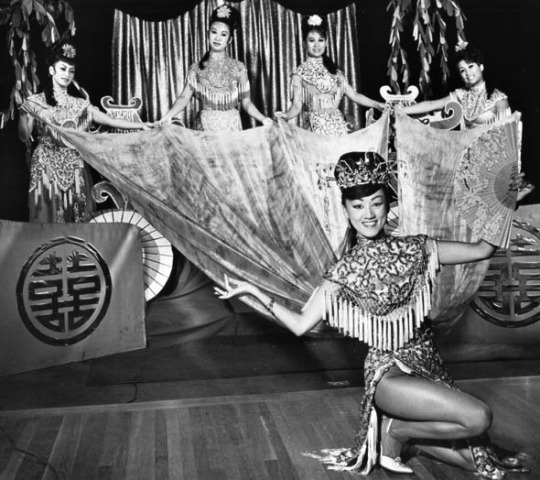
#moli 话#feng nuxi#dislyte#feng nuxi dislyte#chinese nightclubs#chinese history in the u.s#china doll
57 notes
·
View notes
Note
It's such a breath of fresh air seeing art like yours. I've always loved the idea of, but never been able to figure out how to do something like your Vietwardian pieces myself until I saw your work. I love the blending of the two, and it's really inspiring watching you bring a culture into a place it's not seen in.
Aww thank you anon!
I’ve found that much of the historical fashion community is completely oblivious to how much of their aesthetics are borrowed from non-European cultures. They’re familiar with terms like cultural appropriation or Orientalism but are completely ignorant of how deeply ingrained these things are. Which is why I wanted to take a hammer to the whole thing and turn “historical” “accuracy” on its head. Historical fashion that only includes white, Western fashion can never be fully accurate anyway.
Design thoughts under the cut because I have a lot to say!
I felt it was important to do more than just swapping in Vietnamese textiles, because I don’t feel like our textiles are visually distinctive enough to immediately register as Not European. Not least because so many European gowns of the era used Asian textiles. Ahem.
I feel like this is where a lot of modern fashion houses lose me. The clothes are pretty or eyecatching or weird, but I don’t get any sense of who would wear them. And this is especially true when European designers coopt non-European influences. It’s blatantly superficial.
I put a lot of thought into the structure and silhouette of the clothes I’m trying to meld together. Structure being all the individual layers but also the lines of a garment—the shape of the seams, the placement and angle and curvature of darts, the behavior of the different materials. Because I understand the physics of the clothes and the balance of the silhouettes, as well as the way in which they’re worn, I can choose things that will look good together while maintaining the elements that make clothes instantly recognizable.
Then there’s the cultural and social aspect. I like to invent characters to get myself into the headspace of someone actually wearing these clothes. What do they need from their wardrobe? Are they going for conspicuous consumption? Are they someone at the pinnacle of high fashion? Or someone more practical, or someone concerned with modesty?
I wanted to approach the designs from the perspective of young Vietnamese members of high society with the sociopolitical clout to influence and establish fashion trends. They have no interest in abandoning their culture in favor of Western tastes, and they only adopt what suits their fancy.
34 notes
·
View notes